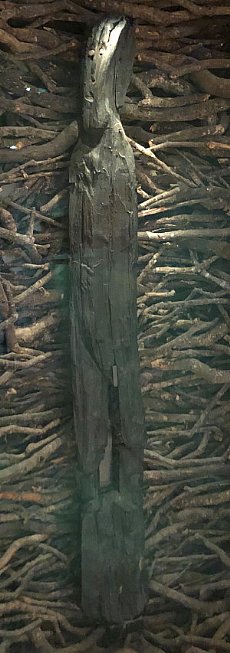The Ballachulish Figure
01 June 2019
- News Type:
- Find of the Month
 The Ballachulish Figure is an almost life-size humanoid wooden figure, found in 1880 during peat cutting in advance of building work at Ballachulish Moss, Lochaber. It was discovered at the base of a peat bog, lying face down on the gravel of an old raised beach 120m from the shore of Loch Leven. Carved of a single block of alder, at the time of its discovery it stood to almost five feet tall. It was interpreted as female. She had a large, heavy and oval-shaped head with inset quartz eyes, large ears, a distinct nose and mouth and a round chin. Outlined on her body were arms starting halfway round her back, hands and fingers. Her trunk was straight and continued into separated legs which joined into a pedestal base. This had a rectangular hollow carved into the front of it.
The Ballachulish Figure is an almost life-size humanoid wooden figure, found in 1880 during peat cutting in advance of building work at Ballachulish Moss, Lochaber. It was discovered at the base of a peat bog, lying face down on the gravel of an old raised beach 120m from the shore of Loch Leven. Carved of a single block of alder, at the time of its discovery it stood to almost five feet tall. It was interpreted as female. She had a large, heavy and oval-shaped head with inset quartz eyes, large ears, a distinct nose and mouth and a round chin. Outlined on her body were arms starting halfway round her back, hands and fingers. Her trunk was straight and continued into separated legs which joined into a pedestal base. This had a rectangular hollow carved into the front of it.
The figure was initially thought to be of early Scandinavian origin, but has since been radiocarbon dated to 728-524 cal BC, making the figure of Early Iron Age date. The figure’s purpose is unknown, and it has been suggested that she could have been a fertility goddess or linked to the crossing of dangerous straits between Loch Leven and the sea, which Ballachulish overlooks. Due to the lack weathering of the figure, it was suggested by Coles (1990) that the figure may have been deliberately disposed of in a way reminiscent of human bog-burials rather than simply toppling over and being subsequently buried by peat.
Whatever the Ballachulish figure’s mysterious purpose, she is unique to Scotland, and remains one of few anthropomorphic figures and possible self-representations of prehistoric people in Scotland. There are only a handful of wooden figures found in Britain and Ireland, of which six were identified and discussed by Coles in 1990, including the Ballachulish figure. These were all radiocarbon dated to between the Bronze Age and Iron Age. Little could be learnt from such a small number if figures about their function within societies who made them, but based on the dating, Coles surmised that these insular examples were loosely related to each other and set apart in several respects from Continental examples of wooden figures.
The Ballachulish figure is today on display at the NMS. She has shrunk, twisted and distorted significantly since her discovery due to early conservations problems and subsequent transport to the museum in 1880. She can be seen in her original state however in an early photo, taken shortly after her discovery which is available on the NMS website (see link below). Even in her altered state, however, the Ballachulish Figure is an impressive sculpture of considerable national importance.
Further Information
https://www.nms.ac.uk/ballachulishfigure
https://her.highland.gov.uk/Monument/MHG4306
Submitted by Grace Woolmer
Find of the Month Archive
- 25/07/2022 Steatite Vessels
- 10/04/2021 Cruisie lamp in Dunrobin Castle Museum
- 02/03/2021 Medieval Sword Pommel from Sleat, Skye
- 01/02/2021 Hilton of Cadboll Pictish Cross Slab
- 04/01/2021 Gunflint from Stoneyfield, Inverness
- 02/12/2020 Bobbin from Contin Bobbin Mill
- 02/11/2020 Russian Lead Cloth Seal from Cromarty
- 01/10/2020 The Poolewe Hoard
- 04/09/2020 Storr Rock Viking Silver Hoard
- 07/08/2020 Mesolithic bloodstone artefacts from Camas Daraich, Skye
